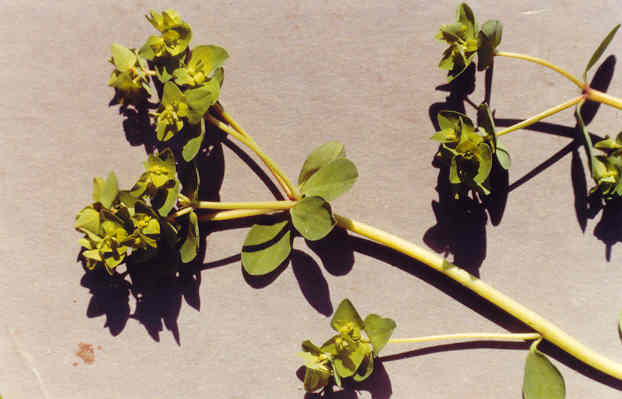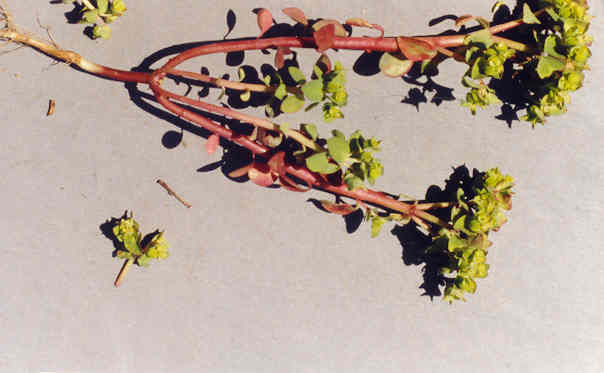
Euphorbia peplus L.
 |
Euphorbia peplus L.
Euphorbiaceae (Spurge Family)EuropePetty Spurge |
April Photo
Plant Characteristics:
Glabrous erect annual, 1-3.5 dm. high, simple or branched from below;
cauline leaves obovate to roundish, obtuse to retuse, 1-2.5 cm. long, distinctly
petioled, entire; floral lvs. ovate, obtuse, 0.6-1.5 cm. long; cyathia 1.5 mm.
high, campanulate; glands large, yellow, with spreading narrow horns; caps. 2
mm. long, each carpel with a broad thin dorsal keel; seeds oblong, 1.2 mm. long,
cellular-punctate, ashy, subhexagonal, the outer faces each with 3-4 rounded
pits, the 2 inner with a longitudinal furrow, no caruncle.
Habitat:
Frequent in moist places as a garden weed, mostly about towns; to
Atlantic Coast; from Eu. Feb.-Aug.
Name:
Euphorbus, physician to the
king of Mauritania 1st century.
Greek, peplis, a plant name for
one of the spurges. (Jaeger 187).
General:
Occasional in the study area. Photographed
in Big Canyon and along the trail from Mariners Dr. to North Star Beach.
(my comments).
E. arenicola was used by the
Moapa Paiutes as a tea for eyewash. (Murphy
39). E.
peplus has been known to cause dermatitis, the milky juice is irritating to
the skin and eyes. If swallowed it causes vomiting, severe gastroenteritis, and
diarrhea. (Fuller 138, 371). (Murphy 39).
The root is highly cathartic and diuretic.
(Meyer 95).
A highly diversified genus of over 1000 species, mostly temperate, many
cactus-like or otherwise highly modified in habit.
(Munz, Flora So. Calif. 409).
Text Ref:
Jepson 602; Hickman, Ed. 574; Munz, Calif.
Flora 168; Munz, Flora So. Calif.
414; Roberts 22.
Photo Ref:
March 5-April 1 85 # 13; March-April 87 # 18; March 4 85 # 24.
Identity: by R. De Ruff.
Computer Ref: Plant Data 29.
Have plant specimen.
Last edit 12/28/02
.
 |
March Photo